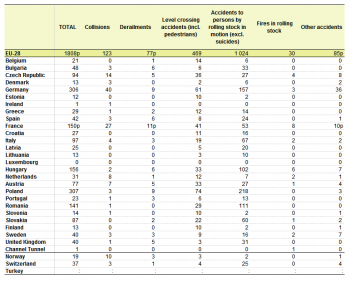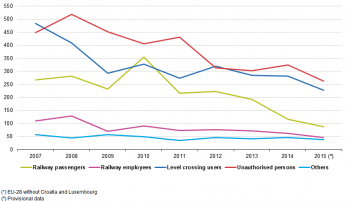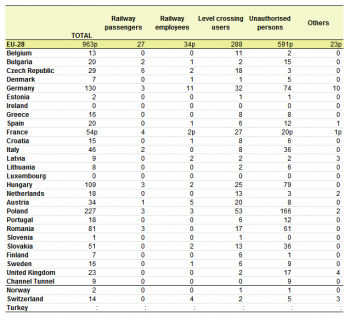Archive:Rail accident fatalities in the EU
- Data from November2016. Most recent data: Further Eurostat information, Main tables and Database. Planned article update: January 2018.
In 2015, 1 808 significant railway accidents have been reported in the EU-28, in which a total of 963 persons were killed; another 684 persons have been seriously injured. At the level of the EU (however without Croatia and Luxembourg for time series consistency), the number of fatalities has gradually decreased, from 1 517 in 2007 to 948 in 2015 (-37%). Suicides occurring on the railways are reported separately, and with 2 762 reported cases in 2015, these outnumber by a considerable margin the victims accounted for in the railway safety statistics.








Main statistical findings
Railway safety data are collected by the European Union Agency for Railways (hereafter ERA) through the Common Safety Indicators (CSIs) since 2006. However, the Member States were only obliged to follow common definitions since 2010, thus only data from 2010 onwards are fully harmonised. As soon as the data are consolidated, these are published through the ERAs ERAIL database and their website (see also Methodological Notes). Eurostat publishes ERA’s data through its dissemination database Eurobase. This article highlights selected elements.
13% fewer accidents in 2015 compared with 2014
The number of railway accidents has been declining between 2007 and 2015 (see Figure 2). At EU level (however without Croatia and Luxembourg for time series consistency), the number has been reduced by well over a half since 2007 (from 3 811 to 1 781 accidents). In 2015, the decrease compared with the previous year was particularly marked (-13%), but not in all categories: the numbers of collisions and fires in rolling stock have barely decreased (data not shown).
Please note that accident figures are only directly comparable from 2010 onwards after the application of common definitions. Prior to 2010, Belgium, Poland and Slovakia typically reported all railway accidents, instead of the significant accidents only. This has led to a lower count in several categories of accidents since 2010.
Looking at the detailed 2015 figures (Table 1), the largest single category of accidents at EU-28 level are accidents to persons caused by rolling stock in motion, representing 57% of all accidents. Typically, these are accidents involving persons that are on the railway tracks ( unauthorised persons or trespassers) and are then hit by a running train. Accidents at level crossings, including pedestrians, is the other important category, with a total number of 469 accidents (26% of the total). Together, these accidents represent 83% of the total number of significant accidents.
Table 1 also shows that Poland and Germany have registered the highest number of accidents; both countries having a share of 17% of all accidents recorded in the EU-28 in 2015. With a total of 156 accidents, the much smaller Member State, Hungary had a share of 8.6%. In Luxembourg not a single accident was reported while in Ireland only one accident occurred (a collision). The Channel Tunnel is listed as a separate entity as a distribution between France and the United Kingdom cannot be made.
Persons seriously injured: noticeable decline since 2007, especially among railway passengers
When observing the 2007-2015 time span at the level of the EU (without Croatia and Luxembourg – see Figure 3), a general downward trend is noted. This trend is noticeable despite occasional year-to-year scatter: whereas the average annual decrease of the total number of seriously injured persons amounted to an average 8.6% per year, those in the category of railway passengers and railway employees show a stronger decrease (-13% and -10% annually on average, respectively). The peak in the railway passengers curve registered in 2010 and is notably influenced by the severe train collision at Buizingen (Belgium), with 171 persons seriously injured. Also, without the most serious single train accident of 2013, the derailment of a high-speed train in Santiago de Compostela (Spain), this decrease would have been more gradual.
Focusing on the year 2015, Table 2 shows that the pattern drawn for the various accident categories is reflected by the number of persons injured. Most persons seriously injured were counted in accidents involving rolling stock in motion (384 persons, or 56% of the total) followed by level crossing accidents (264 persons, or 39%).
Far fewer persons were injured in the other types of accidents. Train collisions claimed 23 seriously injured persons in 2015 (the same number as reported in 2014). In 16 Member States, there were no cases of persons injured in train collisions. The comparison of seriously injured persons between countries may be slightly biased due to differences in reporting regimes. Although 77 train derailments were registered at the level of the EU-28 in 2015, not a single person was seriously injured or killed in such accidents.
Persons killed in rail accidents: over 60% are unauthorised persons on railway premises
Figure 1 at the beginning of this article shows the absolute number of persons killed in railway accidents. Only a fraction of the registered fatalities are actually railway passengers. The total number of fatalities has gradually declined from 1 517 persons in 2007 to 948 persons in 2015 (EU aggregate without Croatia and Luxembourg to ensure equal comparison), a decrease of 37%. Focusing on 2015 fatalities in the category “Unauthorised persons” (see Table 3) expectedly remain the largest group of victims, with 591 cases in 2015 (61% of the total), followed by “Level crossing users” with 288 deaths (30%). Railway passenger fatalities constitute a minor share in both 2011 and 2012, when the proportion was only 3%; in 2013, however, the 97 fatalities reported represented close to 9% of the total number of killed. This increase is solely attributable to the aforementioned accident in Santiago de Compostela in July 2013, with 79 fatalities (representing all of Spain’s fatalities in the category “Railway passengers” and 81% of the fatalities in that category at EU-28 level that year). In 2014, the share of railway passengers in the total number of fatalities was 1.4% whilst in 2015 it amounted to 2.8% (27 deaths among a total of 963).
Rail transport remains a very safe mode of transport. The European Union Agency for Railways has estimated that for the period 2010-2014, the fatality risk for passengers travelling on board of trains was 0.14 fatalities per 1 000 million train-kilometres at the level of the EU (with some Member States having a significantly higher risk than others) and hence by one third lower compared to the risk for a bus/coach passenger, but at least twice as high as that for commercial aircraft passenger (see: “Railway Safety Performance in the European Union – 2016”).
Few fatalities in accidents other than those at level crossings and involving unauthorised persons
Table 4 outlines the fatalities by type of accident and confirms the image drawn when looking at the table by type of user (Table 3). Most fatalities (68% of the total) are found in the category “Accidents to persons by rolling stock in motion”, typically involving persons that are on the railway tracks (unauthorised persons or trespassers) and are then hit by a running train. Together with level-crossing accidents (31%), these two accident types are responsible for 99% of all deaths occurring on railways in the EU.
Suicides occurring on the railways outnumber those killed and seriously injured in accidents by far
Suicides occurring on the railways are reported separately. The numbers rose in the 2010-2012 period and amounted to just under 3 000 in 2012 at the level of the EU-28. The number has remained under that level since then. In 2015, 2 762 suicides were reported, 5% less than in the previous year. The number of suicides is significant in all MSs. With 806 suicides in 2015, Germany alone accounted for close to 30% of the EU-28 total. It is not easy to address measures aiming at preventing suicides from occurring on the railways. Barriers are often built at hot spots and railway station personnel are given training to address situations when suicide attempts might be expected.
Data sources and availability
The sources used for the statistics in this publication are data reported to the European Union Agency for Railways (ERA – www.era.europa.eu). Railway safety data have been collected by the ERA since 2006 through the Common Safety Indicators (CSIs). These were introduced by Annex I of the Railway Safety Directive (Directive 2004/49/EC). Member States have a legal obligation to submit their CSI data to the ERA. The Agency publishes an Overview of safety-related CSIs as soon as data are consolidated. The CSIs data are reported via, and available through ERAIL system at http://erail.era.europa.eu. The full set of CSI data are made available annually through the biennial Railway Safety Performance Report (paper and on-line) and the Safety Overview (on-line only). Eurostat has an agreement with the European Union Agency for Railways to disseminate the data through Eurobase. The data available is a subset of data available at the Agency. Please note that railway accident data are also collected through Annex H of the Regulation providing for statistical returns on railway traffic and transport (Regulation (EC) 91/2003). However, this data collection is foreseen to be phased out, as similar data are available through the ERA. Therefore, similar data can still be found elsewhere in the Eurobase data tree, namely under the “Railway transport” sub-domain, in the section “Railway transport - Accidents (rail_ac)” whereas the ERA data are located in the “Horizontal multi-modal information (tran)” under “Transport safety (tran_sf)”. Comparing these data might occasionally reveal differences as the ERA handles its own compilation procedures and quality checks. Also, whereas data are reported to the ERA by the national safety authorities, data reported to Eurostat in the framework of Regulation 91/2003 are reported by the National Statistical Offices. The latter might depend on data from the same national authorities, but not necessarily so.
Context
National rail networks have different technical specifications for infrastructure – gauge widths, electrification standards and safety and signalling systems – which make it more difficult and costly to run a train from one country to another. EU laws exist to overcome such differences. Creating an integrated European railway area thus requires better technical compatibility –'interoperability'– of infrastructure, rolling stock, signalling and other subsystems of the rail system. Procedures for authorising the use of rolling stock across the EU's rail network also need to be simplified.
The European Union Agency for Railways helps promote interoperability and develop uniform technical standards, a process in which cooperation between EU countries and rail stakeholders is essential.
The European Union Agency for Railways based in Lille/Valenciennes, France, is helping to build an integrated European railway area by improving rail safety and interoperability. Set up in 2006, it develops shared technical specifications and approaches to safety, working closely with stakeholders from the rail sector and national authorities, the EU institutions and other interested parties. Featuring a dedicated safety unit, the Agency also monitors and reports on rail safety in the EU.
The Agency has collected rail safety data since 2006 on the basis of the Common Safety Indicators (CSIs), introduced by Annex I to the Railway Safety Directive (Directive 2004/49/EC). EU countries are legally obliged to submit these to the Agency. It publishes an Overview of safety-related CSIs once data are consolidated. The CSIs data are reported via the ERAIL system and are available the same way. The full set of CSI data is made available in the annually published Railway Safety Performance Report. Accident figures are reliable from 2010 onwards, following the strict application of standard definitions. Belgium, Poland and Slovakia typically reported all railway accidents in the past, instead of significant accidents only. This meant a lower count in several categories of accidents since 2010.
See also
- ERAs Common Safety Indicators
- ERAs report on Railway Safety Performance in the European Union 2014
- Glossary for transport statistics
Further Eurostat information
Database
- Transport, see:
- Multimodal data (tran)
- Transport safety (tran_sf)
- Rail transport safety (tran_sf_rail)
- Rail accidents by type of accident (ERA data) (tran_sf_railac)
- Rail accidents victims by type of accident (ERA data) (tran_sf_railvi)
- Rail accidents involving the transport of dangerous goods (ERA data) (tran_sf_raildg)
- Suicides involving railways (ERA data) (tran_sf_railsu)
- Rail transport safety (tran_sf_rail)
- Transport safety (tran_sf)
Data collected through Annex H of Regulation (EC) 91/2003:
- Transport, see:
- Railway transport (rail)
- Railway transport – Accidents (rail_ac)
- Annual number of victims by type of accident (rail_ac_catvict)
- Annual number of accidents by type of accident (rail_ac_catnmbr)
- Annual number of accidents involving the transport of dangerous goods (rail_ac_dnggood)
- Railway transport – Accidents (rail_ac)
Publications
Methodology / Metadata
Composition of EU aggregates
EU-28: European Union composed of 28 Member States: Belgium (BE), Bulgaria (BG), Czech Republic (CZ), Denmark (DK), Germany (DE), Estonia (EE), Ireland (IE), Greece (EL), Spain (ES), France (FR), Croatia (HR), Italy (IT), Cyprus (CY), Latvia (LV), Lithuania (LT), Luxembourg (LU), Hungary (HU), Malta (MT), the Netherlands (NL), Austria (AT), Poland (PL), Portugal (PT), Romania (RO), Slovenia (SI), Slovakia (SK), Finland (FI), Sweden (SE) and the United Kingdom (UK).
Cyprus, Malta and Iceland have no railways. Liechtenstein's railways, which are operated by ÖBB, are included in the Austrian data.
The tables include the Channel Tunnel as a separate entity. Data referring to it cannot be assigned to either France or the United Kingdom. EU aggregates always include Channel Tunnel figures.
Some data for the most recent reference year may remain provisional for some time. This is linked to ongoing investigations and hence decisions whether to include or exclude certain accidents.